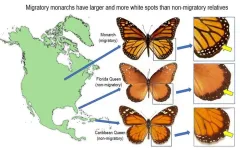(Press-News.org) If you’ve ever wondered how the monarch butterfly got its spots, University of Georgia researchers may have just found the answer.
The new study suggests that the butterflies with more white spots are more successful at reaching their long-distance wintering destination. Although it’s not yet clear how the spots aid the species’ migration, it’s possible that the spots change airflow patterns around their wings.
“We undertook this project to learn how such a small animal can make such a successful long-distance flight,” said lead author Andy Davis, an assistant researcher in UGA’s Odum School of Ecology. “We actually went into this thinking that monarchs with more dark wings would be more successful at migrating because dark surfaces can improve flight efficiency. But we found the opposite.”
The monarchs with less black on their wings and more white spots were the ones that made it to their ultimate destination, nearly 3,000 miles away in south and central Mexico.
“It’s the white spots that seem to be the difference maker,” Davis said.
Migration selects for butterfly spots
The researchers analyzed nearly 400 wild monarch wings collected at different stages of their journey, measuring their color proportions. They found the successful migrant monarchs had about 3% less black and 3% more white on their wings.
An additional analysis of museum specimens that included monarchs and six other butterfly species showed that the monarchs had significantly larger white spots than their nonmigratory cousins.
The only other species that came close to having the same proportion of white spots on its wing was its semi-migratory relative, the southern monarch.
Monarchs use solar energy to improve flight
The authors believe the butterflies’ coloring is related to the amount of radiation they receive during their journey. The monarchs’ longer journey means they’re exposed to more sunlight. As a result, they have evolved to have more white spots.
“The amount of solar energy monarchs are receiving along their journey is extreme, especially since they fly with their wings spread open most of the time,” Davis said. “After making this migration for thousands of years, they figured out a way to capitalize on that solar energy to improve their aerial efficiency.”
But as temperatures continue to rise and alter the solar radiation reaching Earth’s surface, monarchs will likely have to adapt to survive, said Mostafa Hassanalian, co-author of the study and an associate professor at the New Mexico Institute of Mining and Technology.
“With greater solar intensity, some of that aerial efficiency could go away,” Davis said. “That would be yet one more thing that is hindering the species’ fall migration to Mexico.”
Monarch breeding population is stable
But it’s not all bad news for the flying insects.
Davis’ previous work showed that summer populations of monarchs have remained relatively stable over the past 25 years. That finding suggests that the species’ population growth during the summer compensates for butterfly losses due to migration, winter weather and changing environmental factors.
“The breeding population of monarchs seems fairly stable, so the biggest hurdles that the monarch population faces are in reaching their winter destination,” Davis said. “This study allows us to further understand how monarchs are successful in reaching their destination.”
Published in PLOS ONE, the study was co-authored by Christina Vu, from UGA’s Odum School of Ecology, and Paola A. Barriga, from UGA’s Department of Plant Biology; and Brenden Herkenhoff, from New Mexico Tech.
END
Monarchs’ white spots aid migration
The butterflies with larger white spots fly more efficiently, making long trip easier
2023-06-21
ELSE PRESS RELEASES FROM THIS DATE:
Wild and feral cats shed more toxoplasmosis parasites in areas densely populated by humans
2023-06-21
A new analysis suggests that wild, stray, and feral cats living in areas with higher human population density tend to release—or “shed”—a greater amount of the parasite that causes the disease toxoplasmosis. The study also draws links between environmental temperature variation and parasite shedding. Sophie Zhu of the University of California Davis, U.S., and colleagues present these findings in the open-access journal PLOS ONE on June 21.
Toxoplasmosis is a mild-to-severe disease caused by Toxoplasma gondii, which can infect warm-blooded vertebrates, including humans and many wild or domestic animals; for instance, cats, sheep, mice, birds, ...
Young people learn gradually to reflect on mental states, peaking in young adulthood
2023-06-21
The capability to reflect on their own mental state and that of others continues to develop throughout adolescence, with mentalizing scores varying by gender and personality traits, according to a new study published this week in the open-access journal PLOS ONE by Alex Desatnik of University College London, UK, and colleagues.
It has been established that the human brain undergoes a number of important changes during adolescence, especially in the “social brain” regions associated with social cognition. One of the key constructs capturing multiple facets of social cognition is ...
Monarch butterflies are more likely to survive their long migrations if they have more and larger white spots on their wings, possibly because it gives them an aerodynamic advantage
2023-06-21
###
Article URL: https://journals.plos.org/plosone/article?id=10.1371/journal.pone.0286921
Article Title: How the monarch got its spots: Long-distance migration selects for larger white spots on monarch butterfly wings
Author Countries: USA
Funding: The authors received no specific funding for this work. END ...
One in ten NHS healthcare workers experienced suicidal thoughts during pandemic, study finds
2023-06-21
Approximately one in ten NHS healthcare workers experienced suicidal thoughts during the first year of the COVID-19 pandemic, finds a new University of Bristol-led study published in PLOS ONE today [21 June].
Concerns were raised about the risk of suicide among healthcare workers during the pandemic after a number of high-profile cases were reported in the media. Researchers from the University of Bristol, King’s College London and UCL (University College London), sought to investigate the prevalence and incidence of suicidal thoughts and behaviour among NHS healthcare workers in England and their relationship with occupational ...
Repurposed drug shows promise for treating cardiac arrhythmias
2023-06-21
Ruxolitinib, a drug that is already approved by the U.S. Food and Drug Administration (FDA) for treating certain cancers and skin conditions, is effective at inhibiting CaMKII, a protein kinase linked to cardiac arrhythmias.
In a new study published June 21, 2023, in Science Translational Medicine, researchers from Johns Hopkins University and the University of Chicago invented a new reporting technique to monitor activity of CaMKII while screening the effects of nearly 5,000 FDA approved drugs on human cells that expressed the ...
Urgent action needed to further improve child survival in Ethiopia: Study
2023-06-21
New global research on child mortality rates in Ethiopia shows while there has been a significant decline in these rates in past three decades, too many children under the age of five are still dying.
The analysis found the mortality rate in the under-five demographic decreased by almost 4.5 per cent every year between 1990 and 2019.
However, despite the progress, it’s still one of the highest rates in the world with an estimated 190,000 under 5 deaths in 2019 at the rate of 52 deaths per 1000 livebirths. The country’s neonatal mortality rate is 26.6 deaths per 1000 livebirths.
Lead author Dr Gizachew Tessema from the Curtin School of Population ...
Quantum interference can protect and enhance photoexcitation
2023-06-21
When a photon interacts with a material, an interaction occurs that causes its atoms to change their quantum state (a description of the physical properties of nature at the atomic level). The resulting state is called, aptly, photoexcitation. These photoexcitations are conventionally assumed to kill one another when they come near each other, radically limiting their density and mobility. This in turn limits how efficient tools that rely on photoexcitation such as solar cells and light-emitting devices can be.
But in a study published June 19 in the journal Nature Chemistry, scientists at Northwestern University and Purdue University challenge this assumption ...
Reducing bias and stigma associated with medication-assisted treatment improves care
2023-06-21
Medication-assisted treatment (MAT), such as naltrexone, is a well-documented successful treatment for opioid use disorder (OUD). However, there are multiple barriers for clinicians to use MAT, including clinician lack of confidence in using the treatment, their own misconceptions about the patient population, and, until recently, federally required training. Additionally, there is a stigma associated with MAT and the patients who would most benefit from it. Improving access to MAT training and integrating it into clinician programs and curriculums may remove identified barriers, decrease stigma, and enable newly trained clinicians to treat patients.
To address these barriers, ...
UNM researchers find medical cannabis patients who feel 'high' report greater symptom relief but increased negative side effects
2023-06-21
In a new study titled, “Understanding Feeling ‘High’ and Its Role in Medical Cannabis Patient Outcomes,” published in the journal, Frontiers in Pharmacology, researchers at The University of New Mexico, in collaboration with Releaf App™ found that patients who reported feeling “High” experienced 7.7% greater symptom relief and an increase in reporting of positive side effects such as “Relaxed” and “Peaceful.” However, these benefits must be weighed against a more than 20% increase in negative side effect reporting.
Senior author and Associate Professor of Psychology, ...
Screening newborns for "bubble-baby" disease saves lives
2023-06-21
Screening newborns for severe combined immunodeficiency disease (SCID) significantly increases the survival of children after bone marrow transplantation, a new North American study finds.
Published today in The Lancet with an accompanying editorial, the retrospective study was co-led by Elie Haddad, an Université de Montréal medical professor and clinician scientist, pediatrician and immunologist at the UdeM-affiliated CHU Sainte-Justine mother-and-child hospital.
The research shows that the gradual adoption of newborn screening for SCID since 2008 in North America has boosted the survival rate from 73 per cent between 1982 and 2009 to ...
LAST 30 PRESS RELEASES:
Why nail-biting, procrastination and other self-sabotaging behaviors are rooted in survival instincts
Regional variations in mechanical properties of porcine leptomeninges
Artificial empathy in therapy and healthcare: advancements in interpersonal interaction technologies
Why some brains switch gears more efficiently than others
UVA’s Jundong Li wins ICDM’S 2025 Tao Li Award for data mining, machine learning
UVA’s low-power, high-performance computer power player Mircea Stan earns National Academy of Inventors fellowship
Not playing by the rules: USU researcher explores filamentous algae dynamics in rivers
Do our body clocks influence our risk of dementia?
Anthropologists offer new evidence of bipedalism in long-debated fossil discovery
Safer receipt paper from wood
Dosage-sensitive genes suggest no whole-genome duplications in ancestral angiosperm
First ancient human herpesvirus genomes document their deep history with humans
Why Some Bacteria Survive Antibiotics and How to Stop Them - New study reveals that bacteria can survive antibiotic treatment through two fundamentally different “shutdown modes”
UCLA study links scar healing to dangerous placenta condition
CHANGE-seq-BE finds off-target changes in the genome from base editors
The Journal of Nuclear Medicine Ahead-of-Print Tip Sheet: January 2, 2026
Delayed or absent first dose of measles, mumps, and rubella vaccination
Trends in US preterm birth rates by household income and race and ethnicity
Study identifies potential biomarker linked to progression and brain inflammation in multiple sclerosis
Many mothers in Norway do not show up for postnatal check-ups
Researchers want to find out why quick clay is so unstable
Superradiant spins show teamwork at the quantum scale
Cleveland Clinic Research links tumor bacteria to immunotherapy resistance in head and neck cancer
First Editorial of 2026: Resisting AI slop
Joint ground- and space-based observations reveal Saturn-mass rogue planet
Inheritable genetic variant offers protection against blood cancer risk and progression
Pigs settled Pacific islands alongside early human voyagers
A Coral reef’s daily pulse reshapes microbes in surrounding waters
EAST Tokamak experiments exceed plasma density limit, offering new approach to fusion ignition
Groundbreaking discovery reveals Africa’s oldest cremation pyre and complex ritual practices
[Press-News.org] Monarchs’ white spots aid migrationThe butterflies with larger white spots fly more efficiently, making long trip easier


